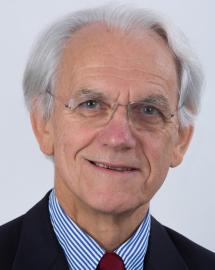Transmutation of radioactive waste by high power laser: the challenge of Gérard Mourou
Nobel Prize in physics in 2018 and professor emeritus at the École polytechnique, Gérard Mourou is a scientist that nothing can stop. After revolutionizing ophthalmic surgery with the invention of a new laser technique, the physicist launched a challenging scientific project, which only a researchers of this fame could imagine: the transmutation of radioactive waste by high-power laser. Andra met him to find out more.
It is on the plateau of Saclay, south of Paris, that we meet Gérard Mourou. Here at École Polytechnique, the Nobel Prize in Physics has been working in his laboratory for many years. His enthusiasm remains intact when it comes to addressing the issue of lasers. His research on the subject represents the project of a lifetime. "For a long time, the power of lasers was limited, due to the risk of destroying them. Alongside Donna Strickland, with whom I share the Nobel Prize, we invented the technique of CPA (Chirped Pulse Amplification): the laser emits an ultrashort pulse that we will stretch a colossal factor before amplifying it. Thanks to the CPA one can produce considerable power, to the order of the petawatt (10e15W), without destroying the laser. This represents the equivalent of a hundred times the world electricity grid, "explains Gérard Mourou.
For the physicist, this new invention opens perspectives in several areas, starting with ophthalmic surgery. An application that came to light as a result of an unlikely combination of circumstances: "One of my students was aligning the laser for an experiment when it got the pulse in the eye. We went to the hospital where an intern found that the damage to the retina was absolutely perfect. This laser was the cleanest knife possible. "
A high power laser with multiple applications?
By further increasing the pulse power of the laser via the CPA technique, Gérard Mourou sees other applications such as the cleaning of space debris, but especially the transmutation of radioactive elements contained in some of the most radioactive and long-lived waste. Already studied in France since the 1991 law (Bataille law) and in international projects such as Myrrha (see box), transmutation aims at transforming long-lived radioactive elements into radioactive elements with shorter lives. "The method remains almost identical, what changes with the laser is the starting point: the impulse that will generate a stream of protons and then trigger the chain reaction with sufficient energy", details the Nobel Prize .

On paper, the solution is promising, but still at the laboratory stage. The transition to an industrial scale, especially in a nuclear environment, is a long and complex process in which uncertainties remain: "We must distinguish between the time when scientific proof can be obtained and the industrial implementation. », Admits Gérard Mourou. The use of lasers to treat radioactive waste requires adequate equipment coupled with a new type of 4th generation reactors, still in the study phase: "The problem with lasers is their efficiency and their repetition (their frequency, Ed). That's why we are working on a project, ICAN, to answer this with an architecture based on fiber optics. But before even projecting on the transmutation of high-level radioactive waste (HA), a step is required: the separation of the different radioactive elements that compose them. To date, research on the subject is underway.
A complementary solution to Cigéo
The laser technique proposed by Gérard Mourou also raises the question of the application to the most radioactive waste already generated: 40% of the total HA waste inventory to dispose of has already been produced. Vitrified and packaged in stainless steel packages, its is earmarked to be disposed of in the future geological disposal facility of Andra, Cigeo, with also long-lived intermediate-level waste (MA-VL). "Radioactive waste transmutation and Cigeo disposal are clearly complementary solutions. This is what I like a lot, there is no confrontation, "says the physicist. A complementarity that Andra also considers since Cigéo is planned to take into account this type of technological breakthroughs. The deployment of the disposal facility is characterized by its progressiveness, adaptability and flexibility.
Ambitious as well as complex project, the transmutation of radioactive waste represents a long-term work for Gérard Mourou: "Everything rushed with the Nobel but it's an idea I've had for a long time. So, the time has come for the research for the physicist, who keeps in a corner of the head the idea of meeting the expectations facing the current climate challenge: "If not for the problem of waste in the nuclear, it would be the ideal, "he concludes.
From Myrrha to lasers: the transmutation research
Myrrha is the research facility project for a nuclear reactor driven by a particle accelerator and conducted by the Belgian Nuclear Energy Center SCK • CEN. It could in particular allow transmutation of radioactive elements contained in some of the most radioactive and long-lived waste. But how does it work? The explanation is given on the Myrrha project site: "The particle accelerator projects protons onto a target and gives rise to the neutrons that will sustain the fission reactions in the reactor. In this process, transmutation is possible thanks to the speed of neutrons capable of breaking the nuclei of radioactive atoms. The products of this fission change in nature and therefore in radioactive life.
In design for over 20 years, the Myrrha project started its first phase of construction in 2017 and could be operational from 2033. But what alternative does Gérard Mourou and his laser offer? The transmutation method is virtually identical except for the generation of the initial protons. The laser here takes the place of the particle accelerator. At high intensity, it is indeed capable of producing a neutron flux. A more practical and cheaper technique according to the physicist.


